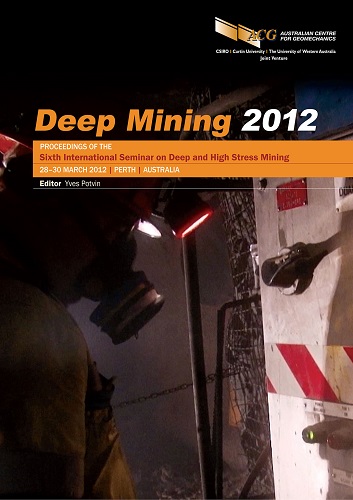How does a caved rock mass behave under confined gravity flow?

|
Authors: Fuenzalida, MA; Castro, RL Paper is not available for download Contact Us |
DOI https://doi.org/10.36487/ACG_rep/1201_31_castro
Cite As:
Fuenzalida, MA & Castro, RL 2012, 'How does a caved rock mass behave under confined gravity flow?', in Y Potvin (ed.), Deep Mining 2012: Proceedings of the Sixth International Seminar on Deep and High Stress Mining, Australian Centre for Geomechanics, Perth, pp. 431-441, https://doi.org/10.36487/ACG_rep/1201_31_castro
Abstract:
Caving methods rely on gravity to break and transport large amounts of ore and waste. The application of massive underground mining is becoming ever more prevalent, specifically caving mines at deeper levels, mainly due to the depletion of mining reserves. It is thus relevant to study mechanisms that occur at deeper levels. Despite the importance of gravity flow, there is a lack of information in the literature about the influence that the confinement (weight of the ore column) has on the geometry of extraction and movement zones. This paper presents the design and results of an experimental set up to investigate the mechanisms of flow of cohesionless materials when drawing from a single drawpoint under confinement. Preliminary experimental results showed that isolated draw zones are mainly influenced by the mass drawn and the confinement applied. Particle size was found to have no significant effect upon the movement and extraction zones. Confinement was found to have a significant effect upon the extraction zone. These conclusions are based upon empirical data to define the parameters thought to be relevant in controlling isolated draw.
References:
Brown, E.T. (2003) Block caving geomechanics, Julius Kruttschnitt Minerals Research Centre, University of Queensland, Brisbane, 1st edition, pp. 245–292.
Castro, R. (2006) Study of the mechanisms of gravity flow for block caving, University of Queensland, Brisbane, Australia.
Flores, G., Karzulovic, A. and Brown, E.T. (2004) Current practices and trends in cave mining, in Proceedings MassMin 2004,
A. Karzulovic and M. Alvaro (eds), 22–25 August, Santiago, Chile, Instituto de Ingenieros de Chile, Santiago, pp. 83–89.
Hustrulid, W. and Mustoe, G. (2004) Some remarks on ore pass design guidelines, in Proceedings MassMin 2004, A. Karzulovic and M. Alvaro (eds), 22–25 August, Santiago, Chile, Instituto de Ingenieros de Chile, Santiago, pp. 301–308.
Janssen, H. (1889) Experiments regarding grain pressure in silos, in Proceedings of MassMin 2004, A. Karzulovic and M. Alvaro (eds), 22–25 August, Santiago, Chile, Instituto de Ingenieros de Chile, Santiago, pp. 293–300.
Kvapil, R. (1965) Gravity flow of granular materials in hoppers and bins, International Journal of Rock Mechanics and Mining Sciences, Vol. 2, pp.35–41.
Laubscher, D. (1994) Cave mining—the state of the art, Journal of the South African Institute of Mining and Metallurgy, pp. 279–93.
Marano, G. (1980) The interaction between adjacent draw points in free flowing materials and its application to mining, Chamber of Mines Journal, Vol. 22, pp. 25–32.
Marsal, R.J. (1973) Mechanical properties of rockfill, Wiley (John) and Sons, pp. 109-200.
McCormick, R.J. (1968) How wide does a drawpoint draw? Engineering and Mining Journal, 169(6), pp. 106-116.
Peters, D. (1984) Physical modelling of the draw behaviour of broken rock in caving, Quarterly of the Colorado School of Mines, Vol. 79, pp. 1–48.
Power, G. (2004) Modelling granular flow in caving mines: large scale physical models and full scale experiments, PhD thesis, University of Queensland.
© Copyright 2025, Australian Centre for Geomechanics (ACG), The University of Western Australia. All rights reserved.
View copyright/legal information
Please direct any queries or error reports to repository-acg@uwa.edu.au
View copyright/legal information
Please direct any queries or error reports to repository-acg@uwa.edu.au